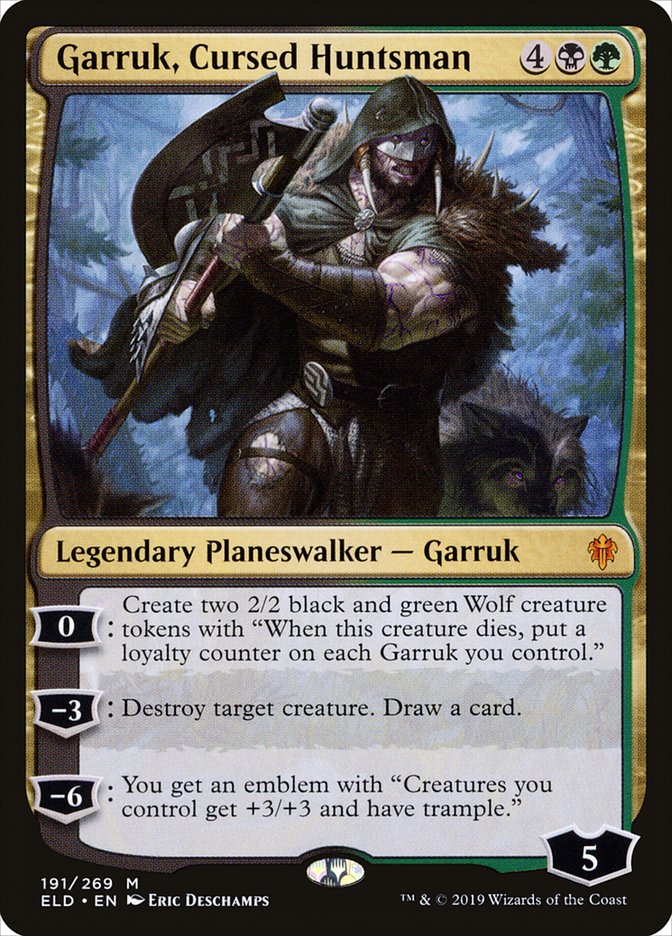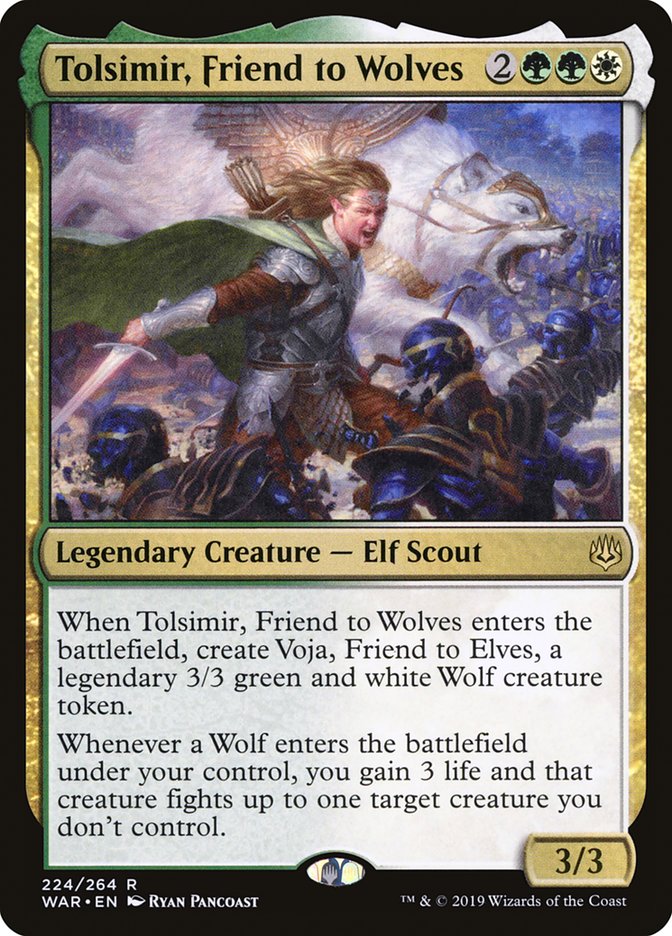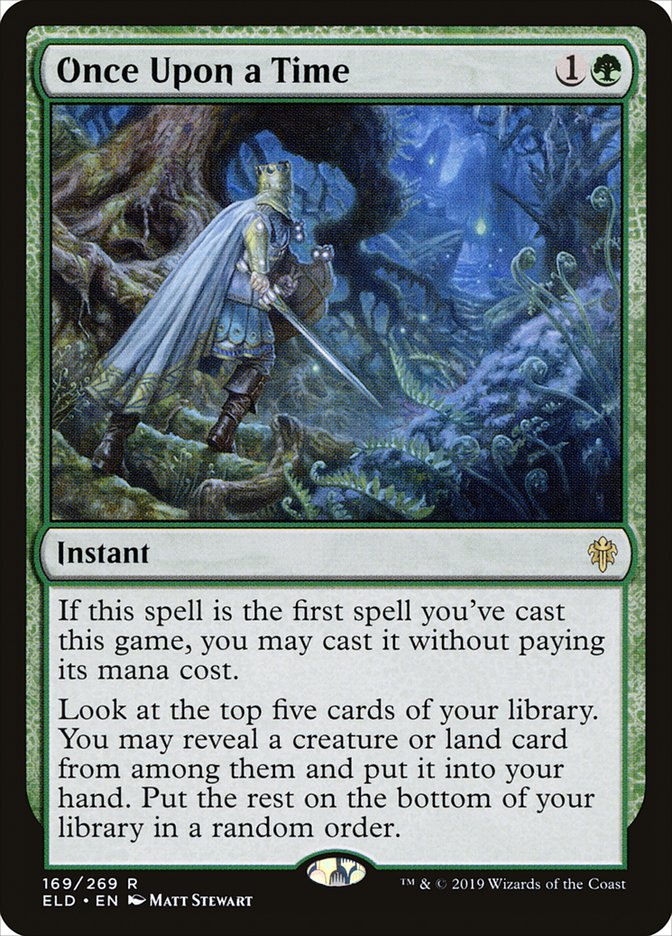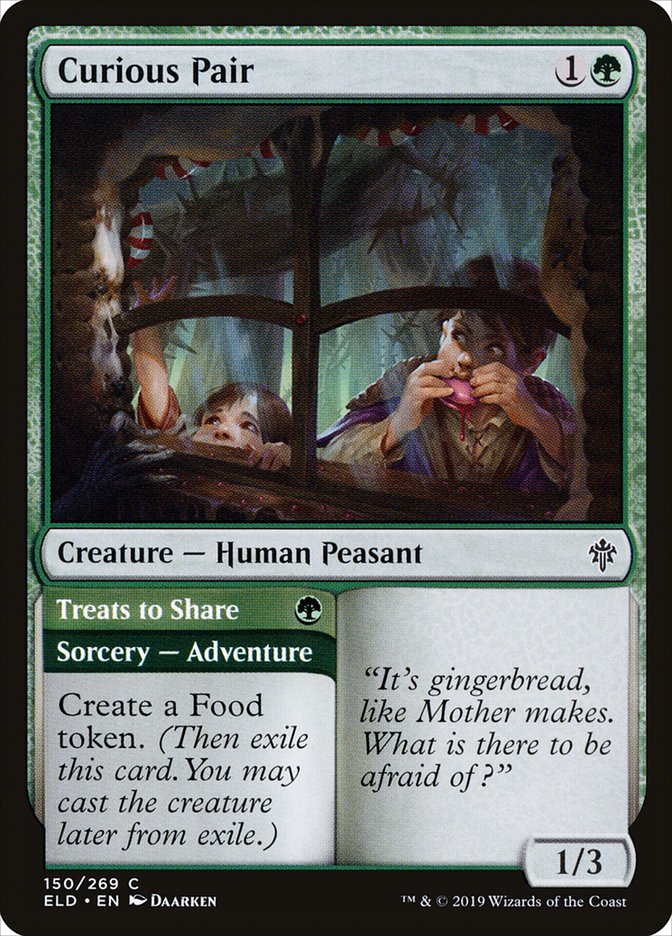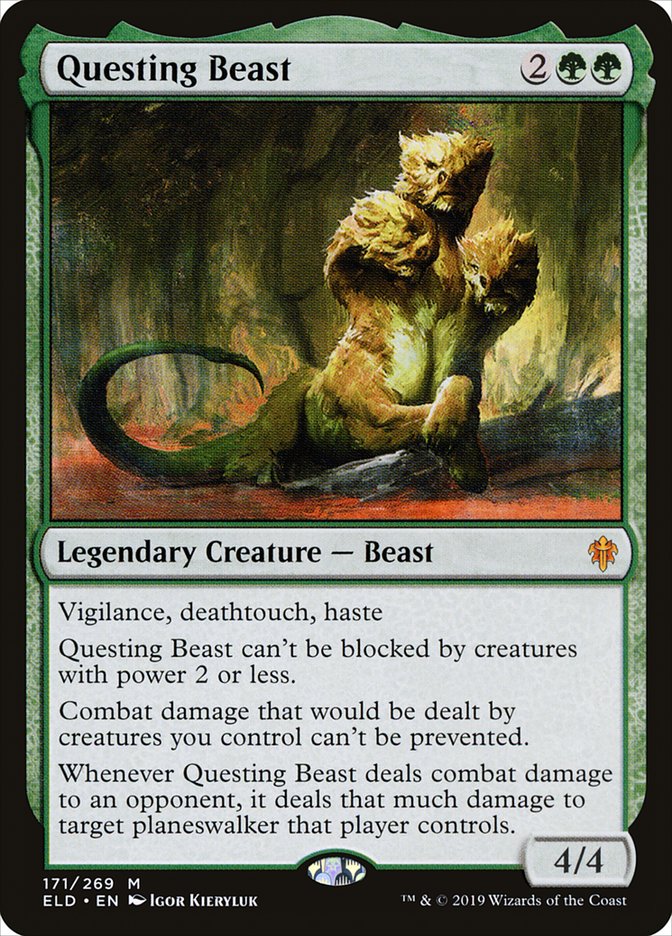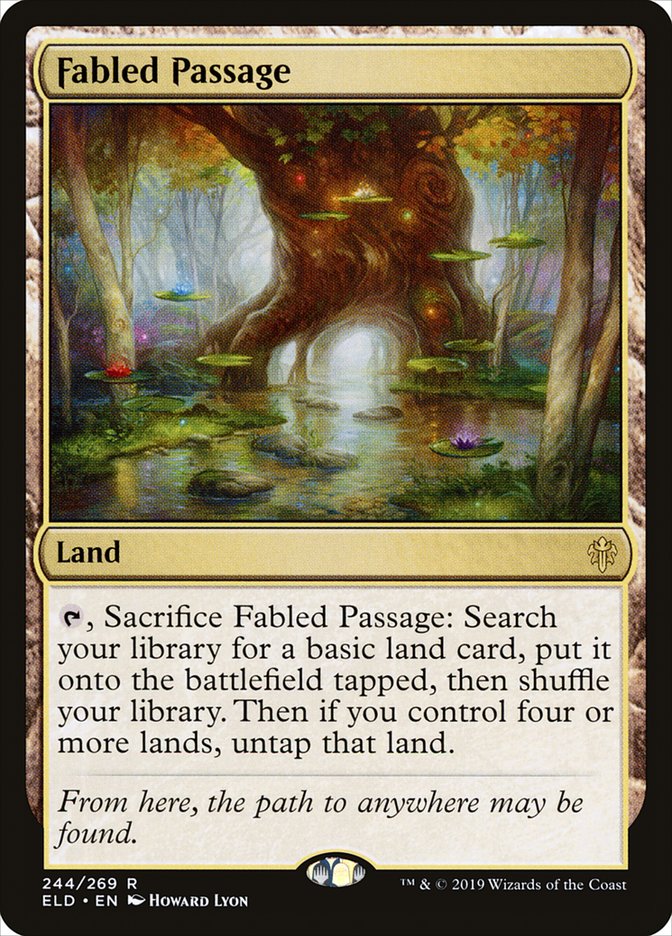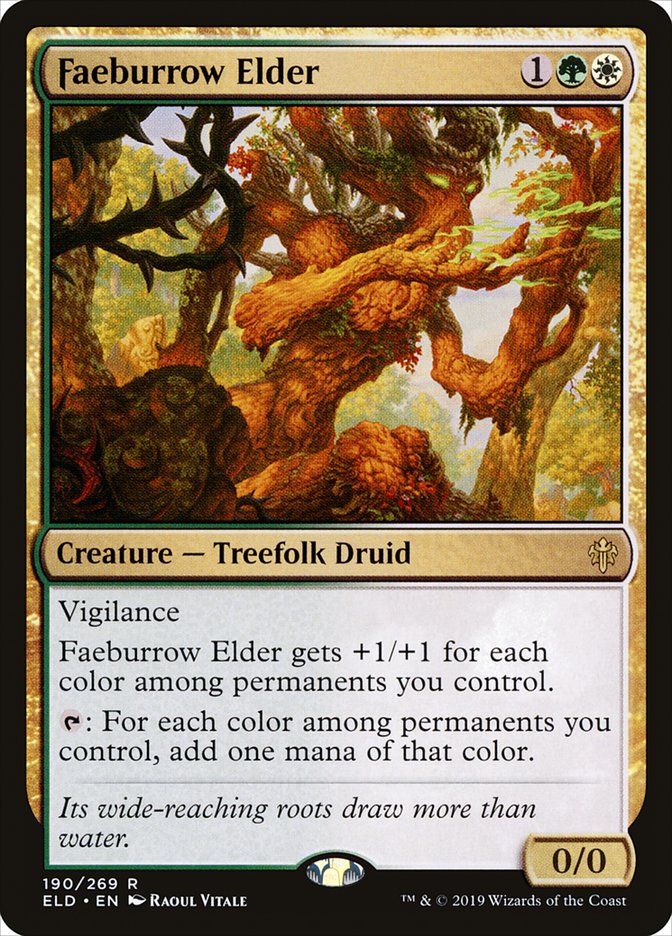With the introduction of Wicked Wolf alongside the extant Tolsimir, Friend to Wolves and Nightpack Ambusher, we finally have the tools to “dance with Wolves” in Throne of Eldraine Standard, especially when combined with the Gilded Goose / Oko, Thief of Crowns Food engine. With the powerful potential curve-outs in this deck, most opponents won’t be able to follow our lead and end up with Wolves dancing all over their faces.
Gabriel Nassif was one of the first to bring a Wolf-themed deck to attention when he streamed Four-Color Wolves last week, and it’s instructive to take a look at his list for some inspiration:
Creatures (23)
- 4 Paradise Druid
- 3 Tolsimir, Friend to Wolves
- 4 Nightpack Ambusher
- 4 Gilded Goose
- 4 Wicked Wolf
- 4 Curious Pair
Planeswalkers (7)
Lands (24)
Spells (6)

This deck is trying to do a lot, and it’s not clear that you are best served by squeezing four colors together. The mana isn’t that good, though Once Upon a Time helps smooth out the colors and lands for most opening hands while making it hard to run out of gas in the mid-game.
The big takeaways from this first foray into Wolves:
1: Garruk, Cursed Huntsman and Tolsimir, Friend to Wolves are the real deal.
Garruk might be our beleaguered protagonist, dancing with Wolves who would die for him, and offering the most power you could ask for in a single card. It’s close with The Great Henge, but Garruk and Tolsimir will immediately clear out opposing creatures, gain a metric ton of life, and clog the battlefield with an army in a very short timeframe.
If you’re going to play midrange in this format, you’d be wise to consider including this package in any list. The power here is on par with Thragtusk, which says something about how good green has gotten with the Throne of Eldraine rotation.
2: Once Upon a Time is an incredible consistency boost.
It’s been said before in a number of contexts, but it bears repeating. Wizards of the Coast is pushing best-of-one play, and they’re increasing their allotment of power cards towards consistency-boosters and flexible answers. See: Angrath’s Rampage, Opt, and now Once Upon a Time. The ripple effects of these decisions extend out to Modern and Legacy, but for Standard, the card fits right in this midrange deck with ramp elements.
Once Upon a Time is a free, creature-type-agnostic Commune with Dinosaurs, and it means that aggressively-slanted green midrange decks are getting an inherent shot in the arm by virtue of having their Turn 1 Gilded Goose or missing shockland a significantly higher percentage of the time. Later in the game, even a two-mana way to dig for Tolsimir or Wicked Wolf is worth quite a bit. This also means we can shave a couple of lands from a traditionally mana-hungry archetype, as with mana ramp creatures and Once Upon a Time, we’re going to have plenty of mana at our disposal when we most need it in the early turns.
The first collection of decks I’ll be looking at for new Standard will undoubtedly include these incredibly overpowered cards. There’s one thing in Gab’s list, though, that won’t be in my deck at MC Richmond.
3: Curious Pair is underpowered.
One thing I won’t be playing in the opening days of new Standard is Curious Pair. That’s a card I just can’t abide by, and there have to be superior alternatives available. Even something as simple as Golden Egg or Incubation Druid would suffice. But a Food token for one mana and a subsequent 1/3 for two mana is neither an enabler of powerful draws early nor a solid card in the middle or late stages of the game. I understand the desire to pack support cards in the deck in order to maximize Oko and the Goose, but this one is a bit too much support and not enough of a card.
4: Where is Questing Beast?
Questing Beast is a keyword monster, gobbling up abilities willy-nilly as it attacks down planeswalkers with ease. It deserves to be in this deck, although as we’ve seen before, it begins to create a glut of four-mana cards that isn’t easily remedied.
After all, you need Wicked Wolf and Nightpack Ambusher to make your Wolf dreams come true, and twelve four-drops is quite a lot without at least the same amount of mana accelerants. A Farseek would do wonders for this deck, but it’s possible that Incubation Druid does enough of what we want that we can include it as our supplementary enabler.
5: Fabled Passage is another super-strong concession to Best-of-One balance.
So much for Evolving Wilds and Terramorphic Expanse, eh? Fabled Passage is another element in the shift towards rebalancing Magic to encourage a better Best-of-One play experience. With green ramp decks, you can either slot in the tapland as appropriate, or just wait until Turn 4, at which point you have the most powerful land in the format. Fabled Passage’s design, in particular, incentivizes people to play midrange decks that require hitting not the first or second, but the fourth or fifth land drop untapped in order to double-spell to catch up to aggro.
Keep that in mind when figuring out what archetype you’re best served building; mana is of paramount importance, and Fabled Passage is better than the Temples for a large subset of midrange decks. If you’re not relying on Golden Goose, you may be better served with Temples, but if you are, it seems like you can’t afford as many tapped lands and may need Fabled Passage instead.
6: What about Faeburrow Elder?
In a four-color deck, Faeburrow Elder can be certifiably broken, with a floor of Palladium Myr and a ceiling of some unholy mana engine on a beefy body with vigilance.
Nassif’s decklist only has Oko as a three-drop follow-up to Gilded Goose, but Faeburrow Elder offers the potential of some truly busted middle turns, with double-spell turns four and five as the norm.
Turn 1: Land, Gilded Goose.
Turn 2: Land, Faeburrow Elder.
Turn 3: Land, Oko, make a Food token, eat the token and tap Faeburrow Elder for three mana, Wicked Wolf, fight an opposing creature.
Turn 4: Garruk, Cursed Huntsman.
My concern is a continued weakness to Stomp (the Adventure half of Bonecrusher Giant). I’m a bit less worried about Teferi, Time Raveler breaking up our curve in the new format, as the advent of Adventure creatures that don’t mind being bounced as well as the powerful Questing Beast mean that card is going to drop off a bit as the format’s predominant fun police. His big brother the Hero of Dominaria is out of the format as well, which means that there’s a lot less incentive to be an Azorius-based midrange or control deck. Despite the high power level of small Teferi, context is everything in Magic.
The support cards are all there for green midrange, and the support cards have diminished greatly for natural predators, so here we are.
Given all that, what does an alternative decklist look like?
Creatures (26)
- 3 Incubation Druid
- 4 Paradise Druid
- 3 Tolsimir, Friend to Wolves
- 4 Nightpack Ambusher
- 4 Gilded Goose
- 2 Questing Beast
- 4 Wicked Wolf
- 2 Faeburrow Elder
Planeswalkers (7)
Lands (23)
Spells (4)

We’re avoiding Temples because we have very strict curve requirements on Turns 1-3. Often, we can’t afford a tapped land without falling behind on our development.
One alternative is to pare down our color requirements, move into straight Abzan, and attempt to leverage Rotting Regisaur and The Great Henge to create a different sort of nut draw.
Creatures (26)
- 4 Incubation Druid
- 4 Paradise Druid
- 3 Tolsimir, Friend to Wolves
- 4 Rotting Regisaur
- 3 Nightpack Ambusher
- 4 Gilded Goose
- 4 Wicked Wolf
Planeswalkers (2)
Lands (22)
Spells (10)

Regisaur and The Great Henge form a totally different and powerful nut draw engine, and The Great Henge offers a very nice bonus for Incubation Druid in particular.
In fact, there’s certainly an alternative decklist around with Incubation Druid, Rotting Regisaur, The Great Henge, and Growth-Chamber Guardian, and it’s worth investigating in its own right. Picking the correct blend of mana and payoffs to minimize fail rates, maximize nut draws, and maintain resilience against interaction is going to be the biggest challenge for tuning midrange decks in this Standard format, because of the abundance of powerful options.
Similar to Questing Beast, Rotting Regisaur doesn’t directly synergize with any of the Wolf themes of the deck, but it’s extremely powerful (again, in a lower-Teferi format, these cards skyrocket in playability).
We can focus more on Regisaur and The Great Henge, more on the Wolf synergies with Garruk and Tolsimir, blend it with Oko and Gilded Goose, keep it Abzan, Sultai, straight Selesnya, Golgari, or even all four greedy colors. Midrange has so many ways to go with Eldraine!
Keep in mind, there are Golos decks that aim to go over the top, Izzet Phoenix decks that aim to disrupt while assembling a low-cost air force to steal wins, and strong removal like Lava Coil, Bonecrusher Giant, and Murderous Rider to pick apart would-be nut draws.
In this format, you’re either the Wolf, or you’re the Food. Dance your way past these obstacles and claim your place at the top of the food chain at the upcoming SCG Invitational.


